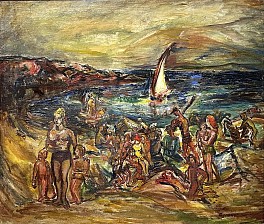BIOGRAPHY

American (1890-2002)
An artist whose career spanned ninety years, Theresa Bernstein was known for her expressive paintings of daily life in the bustling crowds of New York. Bernstein's modernist style and blazing colors were often called masculine by critics, but she often chose to depict women at work and play, from trolley and seashore scenes to suffrage rallies. Bernstein co-founded the Society of Independent Artists in 1916, which allowed any artist to exhibit without juries or prizes. She was a fixture of both the art scene in New York and a respected summer art colony in Gloucester, Massachusetts. Her paintings and prints are now in the collections of museums across the country, including the Metropolitan Museum of Art, the Smithsonian Institution, and the New York Public Library.
As a woman crossing the gender threshold at the beginning of the 20th, Bernstein experienced the excitement of that moment but was not spared the indignity of discrimination. Either paying a reluctant compliment or implying criticism, reviewers often described her work as having a “masculine” style. Whatever the gender construction of her style, she saw as a woman, incorporating into her art types and activities ignored by others, such as women at work, women artists, and suffragist parades.
Bernstein trained in figure painting and portraiture with William Merritt Chase and others, while also drawing inspiration from Robert Henri and his Ashcan colleagues, in addition to modern European artists whose work she encountered abroad as well as at the 1913 Armory Show.
